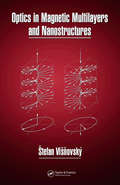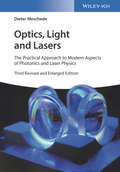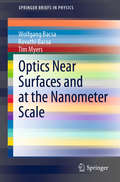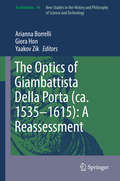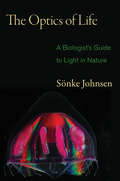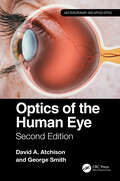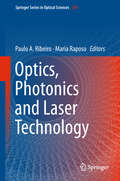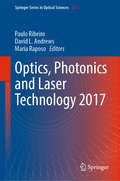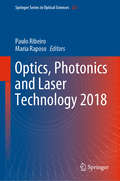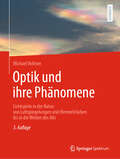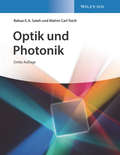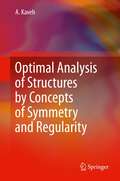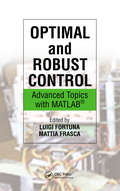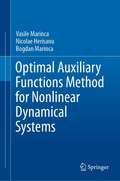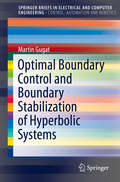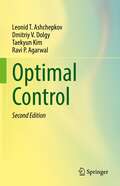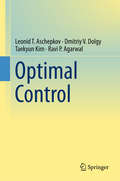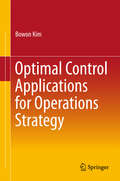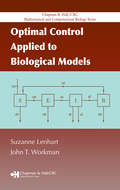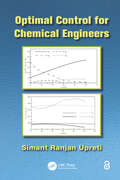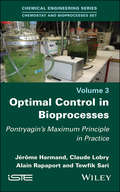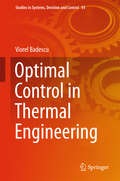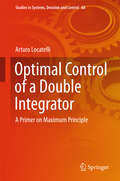- Table View
- List View
Optics in Magnetic Multilayers and Nanostructures (Optical Science and Engineering)
by Stefan VisnovskyIn the continuing push toward optical computing, the focus remains on finding and developing the right materials. Characterizing materials, understanding the behavior of light in these materials, and being able to control the light are key players in the search for suitable optical materials. Optics in Magnetic Multilayers and Nanostructures presents an accessible introduction to optics in anisotropic magnetic media.While most of the literature presents only final results of the complicated formulae for the optics in anisotropic media, this book provides detailed explanations and full step-by-step derivations that offer insight into the procedure and reveal any approximations. Based on more than three decades of experimental research on the subject, the author explains the basic concepts of magnetooptics; nonreciprocal wave propagation; the simultaneous effect of crystalline symmetry and arbitrarily oriented magnetization on the form of permittivity tensors; spectral dependence of permittivity; multilayers at polar, longitudinal, transverse, and arbitrary magnetization; the effect of normal or near-normal incidence on multilayers; and anisotropic multilayer gratings.Making the subject of magnetooptics and anisotropic media approachable by the nonspecialist, Optics in Magnetic Multilayers and Nanostructures serves as an ideal introduction to newcomers and an indispensable reference for seasoned researchers.
Optics in Our Time
by Mohammad D. Al-Amri Mohamed El-Gomati M. Suhail ZubairyLight and light based technologies have played an important role in transforming our lives via scientific contributions spanned over thousands of years. In this book we present a vast collection of articles on various aspects of light and its applications in the contemporary world at a popular or semi-popular level. These articles are written by the world authorities in their respective fields. This is therefore a rare volume where the world experts have come together to present the developments in this most important field of science in an almost pedagogical manner. This volume covers five aspects related to light. The first presents two articles, one on the history of the nature of light, and the other on the scientific achievements of Ibn-Haitham (Alhazen), who is broadly considered the father of modern optics. These are then followed by an article on ultrafast phenomena and the invisible world. The third part includes papers on specific sources of light, the discoveries of which have revolutionized optical technologies in our lifetime. They discuss the nature and the characteristics of lasers, Solid-state lighting based on the Light Emitting Diode (LED) technology, and finally modern electron optics and its relationship to the Muslim golden age in science. The book's fourth part discusses various applications of optics and light in today's world, including biophotonics, art, optical communication, nanotechnology, the eye as an optical instrument, remote sensing, and optics in medicine. In turn, the last part focuses on quantum optics, a modern field that grew out of the interaction of light and matter. Topics addressed include atom optics, slow, stored and stationary light, optical tests of the foundation of physics, quantum mechanical properties of light fields carrying orbital angular momentum, quantum communication, and Wave-Particle dualism in action. <
Optics, Light and Lasers: The Practical Approach to Modern Aspects of Photonics and Laser Physics
by Dieter MeschedeThis new, updated and enlarged edition of the successful and exceptionally well-structured textbook features new chapters on such hot topics as optical angular momentum, microscopy beyond the resolution limit, metamaterials, femtocombs, and quantum cascade lasers. It provides comprehensive and coherent coverage of fundamental optics, laser physics, and important modern applications, while equally including some traditional aspects for the first time, such as the Collins integral or solid immersion lenses. Written for newcomers to the topic who will benefit from the author's ability to explain difficult theories and effects in a straightforward and readily comprehensible way.
Optics Near Surfaces and at the Nanometer Scale (SpringerBriefs in Physics)
by Wolfgang Bacsa Revathi Bacsa Tim MyersThis book explores the physical phenomena underlying the optical responses of nanoscale systems and uses this knowledge to explain their behavior, which is very different to what is encountered on the macroscopic scale. In the first three chapters, the authors discuss important aspects of wave optics on surfaces and at small scales, such as the optical interference near surfaces, the physical origin of the index of refraction, and how imaging optical fields can be used to enhance resolution in optical diffraction microscopy. The last two chapters treat a concept on the consequence of the finite size of the focal spot in optical spectroscopy and how the index of refraction can be related to scattering of an ensemble of discrete scatterers. The concepts described here are important to understanding the optical properties of nanoparticles or nanostructured surfaces and are not covered in most fundamental optics courses. This book is designed for researchers and graduate students looking for an introduction to optics at small scales.
The Optics of Giambattista Della Porta (ca. 1535–1615): A Reassessment
by Arianna Borrelli Giora Hon Yaakov ZikThis volume contains essays that examine the optical works of Giambattista Della Porta, an Italian natural philosopher during the Scientific Revolution. Coverage also explores the science and technology of early modern optics. Della Porta's groundbreaking book, Magia Naturalis (Natural Magic), includes a prototype of the camera. Yet, because of his obsession with magic, Della Porta's scientific achievements are often forgotten. As the contributors argue, his work inspired such great minds as Johanes Kepler and Francis Bacon. After reading this book, researchers, historians, and students will have a better appreciation of this influential scientist. They will also gain a greater understanding of an important period in the history of optics. Readers will learn about Della Porta's experimental method, a process governed by the protocols, aims, and theoretical assumptions of natural magic. Coverage also discusses the material properties and limitations of optical technology in the early 17th century, based on a recently discovered Dutch spyglass. It also demonstrates how diagrams were instrumental in the discovery of the sine law of refraction. In addition, the book includes an in-depth analysis of previously untranslated Latin sources. This makes the material useful to historians of optics unfamiliar with the language. More than 70 illustrations complement the text.
The Optics of Life
by Sonke JohnsenOptics--a field of physics focusing on the study of light--is also central to many areas of biology, including vision, ecology, botany, animal behavior, neurobiology, and molecular biology. The Optics of Life introduces the fundamentals of optics to biologists and nonphysicists, giving them the tools they need to successfully incorporate optical measurements and principles into their research. Sönke Johnsen starts with the basics, describing the properties of light and the units and geometry of measurement. He then explores how light is created and propagates and how it interacts with matter, covering topics such as absorption, scattering, fluorescence, and polarization. Johnsen also provides a tutorial on how to measure light as well as an informative discussion of quantum mechanics. The Optics of Life features a host of examples drawn from nature and everyday life, and several appendixes that offer further practical guidance for researchers. This concise book uses a minimum of equations and jargon, explaining the basic physics of light in a succinct and lively manner. It is the essential primer for working biologists and for anyone seeking an accessible introduction to optics.
Optics of the Human Eye (Multidisciplinary and Applied Optics)
by David A. AtchisonThis book describes the optical structure and optical properties of the human eye. For ease of reference, the most commonly useful topics are at the beginning and topics with narrower appeal are placed towards the end. The book is divided into five sections, covering: Basic optical structure of the eye, including the refracting components, the pupil, axes, and simple models of the eye Image formation and refraction of the eye, including refractive errors, measurement, and correction Interactions between light and the eye, considering transmission, reflection, and scatter in the media and at the fundus Aberrations and retinal image quality Depth-of-field and age-related changes in the optics of the eye There have been many developments in the field of visual optics since the first edition was published in 2000. There have been advances in instrumentation for imagery, biometry, and aberrations of the eye. The refraction anomaly of myopia has increased in prevalence throughout the world, and is getting increasing attention because of its association with ocular pathology in the middle and later years of life. Ocular aberrations are now considered in terms of Zernike polynomials rather than Taylor polynomials. Aberrations can be manipulated to better understand their effects on visual performance to improve imagery of the retina for the betterment of diagnosis of various ocular conditions, and to treat the progression of myopia in children. To deal with these developments, the section on aberrations and retinal image quality has undergone considerable revision. This book will be an invaluable purchase for all those with an interest in vision, such as optometrists, ophthalmologists, vision scientists, optical physics, and student of visual optics. An understanding of the optics of the human eye is particular important to designers of ophthalmic diagnostic equipment and visual optical systems such as telescopes.
Optics, Photonics and Laser Technology: Proceedings Of The 2nd International Conference On Photonics, Optics And Laser Technology Revised Selected Papers (Springer Proceedings in Physics #177)
by Maria Raposo Paulo A. RibeiroThis book covers key theoretical and practical aspects of optics, photonics and lasers. It addresses optical instrumentation and metrology, photonic and optoelectronic materials and devices, nanophotonics, organic and bio-photonics and high-field phenomena. Researchers, engineers, students and practitioners interested in any of these fields will find a wealth of new methods, technologies, advanced prototypes, systems, tools and techniques, as well as general surveys outlining future directions.
Optics, Photonics and Laser Technology 2017 (Springer Series in Optical Sciences #222)
by David L. Andrews Maria Raposo Paulo RibeiroThis book discusses both the theoretical and practical aspects of optics, photonics and lasers, presenting new methods, technologies, advanced prototypes, systems, tools and techniques as well as a general survey indicating future trends and directions. The main fields addressed include nonlinear optical phenomena, photonics for energy, high-field phenomena, photonic and optoelectronic sensors and devices, optical communications, biomedical optics and photonics. It also covers a large spectrum of materials, ranging from semiconductor-based optical materials to optical glasses, organic materials, photorefractive materials and nanophotonic materials, as well as applications such as metrology, optometry, adaptive optics, all optical instrumentation, optical communications, quantum information, lighting technologies, energy harvesting and optically based biomedical diagnosis and therapeutics.
Optics, Photonics and Laser Technology 2018 (Springer Series in Optical Sciences #223)
by Maria Raposo Paulo RibeiroThis book includes both theoretical and practical aspects within optics, photonics and lasers. The book provides new methods, technologies, advanced prototypes, systems, tools and techniques as well as a general survey indicating future trends and directions. The main fields of this book are Optical scattering, plasmas technologies and simulation, photonic and optoelectronic sensors and devices, optical fiber sensing and monitoring, image detection and Imaging solid state lasers and fiber lasers, and optical amplifiers. A wide range of optical materials is covered, from semiconductor based optical materials, optical crystals and optical glasses.
Optik und ihre Phänomene: Lichtspiele in der Natur: von Luftspiegelungen und Himmelsfarben bis in die Weiten des Alls
by Michael VollmerDieses Lehr-, Lern-, Fach- und Sachbuch präsentiert die Grundlagen der Optik in Theorie und ausführlich beschriebenem Experiment sowie vielfältige faszinierende optische Phänomene. Ob in Vorlesungen, Seminaren, für Projektarbeiten, Schulunterricht oder Selbststudium - dieses Buch ist eine wertvolle Ressource für alle, die sich für Optik interessieren. Durch die große Zahl zitierter Originalarbeiten schlägt es nicht nur die Brücke zur Lehre sondern auch zur Forschung. Besonderheiten: Das Buch besticht durch seine über 1000 Abbildungen, darunter über 200 qualitativ hochwertige Farbfotos optischer Naturphänomene sowie einer großen Zahl an wissenschaftlichen und physikdidaktischen Literaturangaben für weiterführende Studien. Die Kapitel sind jeweils auch einzeln lesbar, aber zusammen ist es eine einmalige Kombination aus einführendem Lehrbuch der klassischen Optik und detaillierter up-to-date Zusammenstellung von Anwendungen im Bereich optischer Naturphänomene. Thematisch spannt es einen sehr weiten Bogen: von geometrischer, Wellen- und Quantenoptik, Radiometrie und Photometrie über Farbtheorien und technische Anwendungen wie Spektroskopie bis hin zu Naturphänomenen oder der Frage warum der Himmel nachts dunkel ist. Die Grundlagen werden vertieft durch zahlreiche Verständnisfragen und Übungsaufgaben zusätzlich zu vielen Anwendungsbeispielen, die von Fensterreflexionen über Lichtwellenleiter und Smartphoneobjektive bis hin zu modernen Beamern reichen. Inhalt: 1. Einleitung .- 2. Geometrische Optik .- 3. Wellenoptik .- 4. Wechselwirkung von Strahlung mit Materie: Quantenoptik .- 5. Detektoren und Lichtquellen .- 6. Visuelle Wahrnehmung .- 7. Die Atmosphäre der Erde .- 8. Luftspiegelungen.- 9. Regenbögen .- 10. Koronen, Glorien und verwandte Erscheinungen .- 11. Haloerscheinungen am Himmel.- 12. Lichtstreuung und Himmelsfarben .- 13. Weitere Phänomene aufgrund von Lichtstreuung .- 14. Bis in die Stratosphäre und darüber hinaus Neuerungen (zur 2.Aufl.): Der erste Lehrbuchteil zu den Grundlagen ist komplett neu hinzugefügt. Der zweite Teil zu den Anwendungen und Naturphänomenen wurde komplett überarbeitet und aktualisiert. Zudem illustrieren nun über 200 Farbfotos die Phänomene. Die Zielgruppe: Sowohl interessierte Laien - mit und ohne Vorwissen - und Lehrkräfte an Schulen als auch Studierende diverser Fachrichtungen sowie deren Lehrende profitieren von dieser umfangreichen Zusammenstellung. Optik wird nicht nur im Bachelor bzw. Master in Physik u. Astronomie bzw. Astrophysik sowie in den Naturwissenschaften thematisiert, sondern auch in Studiengängen mit Schwerpunkten wie Licht- und Beleuchtungstechnik, Lasertechnik, optische Technologien, Optoelektronik und Photonik, Augenoptik, Meteorologie, uvm. Vorkenntnisse: Erforderlich ist kein besonderes Vorwissen, allerdings ermöglichen manche der angegebenen Querbezüge ein tieferes Verständnis, welches sich erst mit Vorkenntnissen aus einigen Grundlagenfächern der Physik, insbesondere des Elektromagnetismus, der Festkörperphysik sowie der Quantenphysik vollständig erschließt.
Optik und Photonik
by Bahaa E. Saleh Malvin Carl TeichVollständig überarbeitete Neuauflage des maßgeblichen Grundlagen-Lehrbuchs zur Optik und Photonik - umfassend überarbeitet und mit einem neuen Kapitel zur Metamaterialoptik erweitert Die Optik ist eines der ältesten und faszinierendsten Teilgebiete der Physik und fest in den Curricula des Physikstudiums verankert. Sie beschäftigt sich mit der Ausbreitung von Licht und Phänomenen wie Interferenz, Brechung, Beugung und optischen Abbildungen. Die Photonik umfasst optische Phänomene, die primär auf der Wechselwirkung von (quantisiertem) Licht und Materie beruhen, und befasst sich mit dem Verständnis und der Entwicklung optischer Bauteile und Systeme wie etwa Lasern, LEDs und photonischen Kristallen. In bewährter Weise gibt die vollständig überarbeitete und erweiterte Neuauflage des "Saleh/Teich" eine Einführung in die Grundlagen der Optik und Photonik für Studierende der Physik und verwandter Wissenschaften. Ausführliche Erklärungen, rund 1000 Abbildungen und die zur quantitativen Durchdringung notwendige Mathematik ermöglichen ein tiefes Verständnis aller Teilgebiete der klassischen und modernen Optik. * Umfassend und verständlich: sämtliche Grundlagen der Optik und Photonik in einem Werk vereint * Geschrieben von hervorragenden Didaktikern mit langer Lehrerfahrung: optische Phänomene und deren Physik stehen im Vordergrund, der notwendige mathematische Apparat wird behutsam entwickelt * Überarbeitet und erweitert: alle Kapitel wurden mit Blick auf noch bessere Verständlichkeit kritisch geprüft und aktualisiert * Komplett neu: umfangreiches Kapitel zu Metamaterialoptik "Optik und Photonik" richtet sich an Bachelor- und Master-Studierende der Physik, Materialwissenschaften und Ingenieurwissenschaften.
Optimal Analysis of Structures by Concepts of Symmetry and Regularity
by Ali KavehOptimal analysis is defined as an analysis that creates and uses sparse, well-structured and well-conditioned matrices. The focus is on efficient methods for eigensolution of matrices involved in static, dynamic and stability analyses of symmetric and regular structures, or those general structures containing such components. Powerful tools are also developed for configuration processing, which is an important issue in the analysis and design of space structures and finite element models. Different mathematical concepts are combined to make the optimal analysis of structures feasible. Canonical forms from matrix algebra, product graphs from graph theory and symmetry groups from group theory are some of the concepts involved in the variety of efficient methods and algorithms presented. The algorithms elucidated in this book enable analysts to handle large-scale structural systems by lowering their computational cost, thus fulfilling the requirement for faster analysis and design of future complex systems. The value of the presented methods becomes all the more evident in cases where the analysis needs to be repeated hundreds or even thousands of times, as for the optimal design of structures by different metaheuristic algorithms. The book is of interest to anyone engaged in computer-aided analysis and design and software developers in this field. Though the methods are demonstrated mainly through skeletal structures, continuum models have also been added to show the generality of the methods. The concepts presented are not only applicable to different types of structures but can also be used for the analysis of other systems such as hydraulic and electrical networks.
OPTIMAL and ROBUST CONTROL: Advanced Topics With Matlab®
by Luigi Fortuna Mattia FrascaWhile there are many books on advanced control for specialists, there are few that present these topics for nonspecialists. Assuming only a basic knowledge of automatic control and signals and systems, Optimal and Robust Control: Advanced Topics with MATLAB® offers a straightforward, self-contained handbook of advanced topics and tools in automatic control. Techniques for Controlling System Performance in the Presence of Uncertainty The book deals with advanced automatic control techniques, paying particular attention to robustness—the ability to guarantee stability in the presence of uncertainty. It explains advanced techniques for handling uncertainty and optimizing the control loop. It also details analytical strategies for obtaining reduced order models. The authors then propose using the Linear Matrix Inequalities (LMI) technique as a unifying tool to solve many types of advanced control problems.
Optimal Auxiliary Functions Method for Nonlinear Dynamical Systems
by Vasile Marinca Nicolae Herisanu Bogdan MarincaThis book presents the optimal auxiliary functions method and applies it to various engineering problems and in particular in boundary layer problems. The cornerstone of the presented procedure is the concept of “optimal auxiliary functions” which are needed to obtain accurate results in an efficient way. Unlike other known analytic approaches, this procedure provides us with a simple but rigorous way to control and adjust the convergence of the solutions of nonlinear dynamical systems. The optimal auxiliary functions are depending on some convergence-control parameters whose optimal values are rigorously determined from mathematical point of view. The capital strength of our procedure is its fast convergence, since after only one iteration, we obtain very accurate analytical solutions which are very easy to be verified. Moreover, no simplifying hypothesis or assumptions are made. The book contains a large amount of practical models from various fields of engineering such as classical and fluid mechanics, thermodynamics, nonlinear oscillations, electrical machines, and many more. The book is a continuation of our previous books “Nonlinear Dynamical Systems in Engineering. Some Approximate Approaches”, Springer-2011 and “The Optimal Homotopy Asymptotic Method. Engineering Applications”, Springer-2015.
Optimal Boundary Control and Boundary Stabilization of Hyperbolic Systems
by Martin GugatThis brief considers recent results on optimal control and stabilization of systems governed by hyperbolic partial differential equations, specifically those in which the control action takes place at the boundary. The wave equation is used as a typical example of a linear system, through which the author explores initial boundary value problems, concepts of exact controllability, optimal exact control, and boundary stabilization. Nonlinear systems are also covered, with the Korteweg-de Vries and Burgers Equations serving as standard examples. To keep the presentation as accessible as possible, the author uses the case of a system with a state that is defined on a finite space interval, so that there are only two boundary points where the system can be controlled. Graduate and post-graduate students as well as researchers in the field will find this to be an accessible introduction to problems of optimal control and stabilization.
Optimal Control
by Ravi P. Agarwal Dmitriy V. Dolgy Taekyun Kim Leonid T. AshchepkovThis textbook, now in its second edition, results from lectures, practical problems, and workshops on Optimal Control, given by the authors at Irkutsk State University, Far Eastern Federal University (both in Vladivostok, Russia), and Kwangwoon University (Seoul, South Korea).In this work, the authors cover the theory of linear and nonlinear systems, touching on the basic problem of establishing the necessary and sufficient conditions of optimal processes. Readers will find two new chapters, with results of potential interest to researchers with a focus on the theory of optimal control, as well as to those interested in applications in Engineering and related sciences. In addition, several improvements have been made through the text.This book is structured in three parts. Part I starts with a gentle introduction to the basic concepts in Optimal Control. In Part II, the theory of linear control systems is constructed on the basis of the separation theorem and the concept of a reachability set. The authors prove the closure of reachability set in the class of piecewise continuous controls and touch on the problems of controllability, observability, identification, performance, and terminal control. Part III, in its turn, is devoted to nonlinear control systems. Using the method of variations and the Lagrange multipliers rule of nonlinear problems, the authors prove the Pontryagin maximum principle for problems with mobile ends of trajectories. Problem sets at the end of chapters and a list of additional tasks, provided in the appendix, are offered for students seeking to master the subject. The exercises have been chosen not only as a way to assimilate the theory but also as to induct the application of such knowledge in more advanced problems.
Optimal Control
by Leonid T. Aschepkov Dmitriy V. Dolgy Taekyun Kim Ravi P. AgarwalThis book is based on lectures from a one-year course at the Far Eastern Federal University (Vladivostok, Russia) as well as on workshops on optimal control offered to students at various mathematical departments at the university level. The main themes of the theory of linear and nonlinear systems are considered, including the basic problem of establishing the necessary and sufficient conditions of optimal processes. In the first part of the course, the theory of linear control systems is constructed on the basis of the separation theorem and the concept of a reachability set. The authors prove the closure of a reachability set in the class of piecewise continuous controls, and the problems of controllability, observability, identification, performance and terminal control are also considered. The second part of the course is devoted to nonlinear control systems. Using the method of variations and the Lagrange multipliers rule of nonlinear problems, the authors prove the Pontryagin maximum principle for problems with mobile ends of trajectories. Further exercises and a large number of additional tasks are provided for use as practical training in order for the reader to consolidate the theoretical material.
Optimal Control and Geometry: Integrable Systems
by Velimir JurdjevicThe synthesis of symplectic geometry, the calculus of variations and control theory offered in this book provides a crucial foundation for the understanding of many problems in applied mathematics. Focusing on the theory of integrable systems, this book introduces a class of optimal control problems on Lie groups, whose Hamiltonians, obtained through the Maximum Principle of optimality, shed new light on the theory of integrable systems. These Hamiltonians provide an original and unified account of the existing theory of integrable systems. The book particularly explains much of the mystery surrounding the Kepler problem, the Jacobi problem and the Kovalevskaya Top. It also reveals the ubiquitous presence of elastic curves in integrable systems up to the soliton solutions of the non-linear Schroedinger's equation. Containing a useful blend of theory and applications, this is an indispensable guide for graduates and researchers in many fields, from mathematical physics to space control.
Optimal Control Applications for Operations Strategy
by Bowon KimThis book focuses on the applications of optimal control theory to operations strategy and supply chain management. It emphasizes the importance of optimal control theory as a tool to analyze and understand fundamental issues in the respective fields. Delving deeper, the book also elaborates on how optimal control theory provides managerial and economic insights, enabling readers to comprehend the dynamic activities and interactions in operations. Given that optimal control theory is not a dominant approach to studying operations management in the current literature, this book fills that gap by showing its effectiveness as a tool to supplement other methodologies in operations.
Optimal Control Applied to Biological Models (Chapman & Hall/CRC Mathematical Biology Series)
by Suzanne Lenhart John T. WorkmanFrom economics and business to the biological sciences to physics and engineering, professionals successfully use the powerful mathematical tool of optimal control to make management and strategy decisions. Optimal Control Applied to Biological Models thoroughly develops the mathematical aspects of optimal control theory and provides insight into t
Optimal Control for Chemical Engineers
by Simant Ranjan UpretiThis self-contained book gives a detailed treatment of optimal control theory that enables readers to formulate and solve optimal control problems. With a strong emphasis on problem solving, it provides all the necessary mathematical analyses and derivations of important results, including multiplier theorems and Pontryagin's principle. The text presents various examples and basic concepts of optimal control and describes important numerical methods and computational algorithms for solving a wide range of optimal control problems, including periodic processes.
Optimal Control in Bioprocesses: Pontryagin's Maximum Principle in Practice
by Jérôme Harmand Claude Lobry Alain Rapaport Tewfik SariOptimal control is a branch of applied mathematics that engineers need in order to optimize the operation of systems and production processes. Its application to concrete examples is often considered to be difficult because it requires a large investment to master its subtleties. The purpose of Optimal Control in Bioprocesses is to provide a pedagogical perspective on the foundations of the theory and to support the reader in its application, first by using academic examples and then by using concrete examples in biotechnology. The book is thus divided into two parts, the first of which outlines the essential definitions and concepts necessary for the understanding of Pontryagin’s maximum principle – or PMP – while the second exposes applications specific to the world of bioprocesses. This book is unique in that it focuses on the arguments and geometric interpretations of the trajectories provided by the application of PMP.
Optimal Control in Thermal Engineering
by Viorel BadescuThis book is the first major work covering applications in thermal engineering and offering a comprehensive introduction to optimal control theory, which has applications in mechanical engineering, particularly aircraft and missile trajectory optimization. The book is organized in three parts: The first part includes a brief presentation of function optimization and variational calculus, while the second part presents a summary of the optimal control theory. Lastly, the third part describes several applications of optimal control theory in solving various thermal engineering problems. These applications are grouped in four sections: heat transfer and thermal energy storage, solar thermal engineering, heat engines and lubrication. Clearly presented and easy-to-use, it is a valuable resource for thermal engineers and thermal-system designers as well as postgraduate students.
Optimal Control of a Double Integrator
by Arturo LocatelliThis book provides an introductory yet rigorous treatment of Pontryagin's Maximum Principle and its application to optimal control problems when simple and complex constraints act on state and control variables, the two classes of variable in such problems. The achievements resulting from first-order variational methods are illustrated with reference to a large number of problems that, almost universally, relate to a particular second-order, linear and time-invariant dynamical system, referred to as the double integrator. The book is ideal for students who have some knowledge of the basics of system and control theory and possess the calculus background typically taught in undergraduate curricula in engineering. Optimal control theory, of which the Maximum Principle must be considered a cornerstone, has been very popular ever since the late 1950s. However, the possibly excessive initial enthusiasm engendered by its perceived capability to solve any kind of problem gave way to its equally unjustified rejection when it came to be considered as a purely abstract concept with no real utility. In recent years it has been recognized that the truth lies somewhere between these two extremes, and optimal control has found its (appropriate yet limited) place within any curriculum in which system and control theory plays a significant role.
